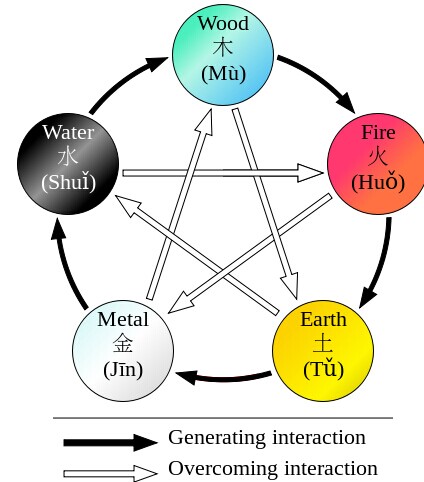- Home >>
- Traditional Chinese medicine 3)--Five Phases theory
Five Phases theory

Five Phases (五行, pinyin: wǔ xíng), sometimes also translated as the "Five Elements" theory, presumes that all phenomena of the universe and nature can be broken down into five elemental qualities – represented by wood (木, pinyin: mù), fire (火pinyin: huǒ), earth (土, pinyin: tǔ), metal (金, pinyin: jīn), and water (水, pinyin: shuǐ). In this way, lines of correspondence can be drawn:
| Phenomenon | Wood | Fire | Earth | Metal | Water |
|---|---|---|---|---|---|
| Direction | east | south | center | west | north |
| Colour | green/blue | red | yellow | white | black |
| Climate | wind | heat | damp | dryness | cold |
| Taste | sour | bitter | sweet | acrid | salty |
| Zang Organ | Liver | Heart | Spleen | Lung | Kidney |
| Fu Organ | Gallbladder | Small Intestine | Stomach | Large Intestine | Bladder |
| Sense organ | eye | tongue | mouth | nose | ears |
| Facial part | above bridge of nose | between eyes, lower part | bridge of nose | between eyes, middle part | cheeks (below cheekbone) |
| Eye part | iris | inner/outer corner of the eye | upper and lower lid | sclera | pupil |
Strict rules are identified to apply to the relationships between the Five Phases in terms of sequence, of acting on each other, of counteraction etc. All these aspects of Five Phases theory constitute the basis of the zàng-fǔ concept, and thus have great influence regarding the TCM model of the body. Five Phase theory is also applied in diagnosis and therapy.
Correspondences between the body and the universe have historically not only been seen in terms of the Five Elements, but also of the "Great Numbers" (大數, pinyin: dà shū) For example, the number of acu-points has at times been seen to be 365, in correspondence with the number of days in a year; and the number of main meridians – 12 – has been seen in correspondence with the number of rivers flowing through the ancient Chinese empire .



